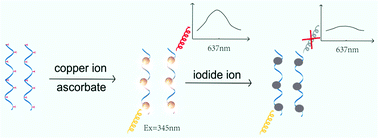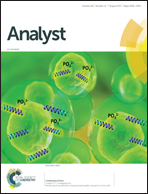A fast, highly sensitive and selective assay of iodide ions with single-stranded DNA-templated copper nanoparticles as a fluorescent probe for its application in Kunming mice samples†
Abstract
The development of fast, sensitive, selective and flexible methods for the detection of iodide is highly demanded and is of great significance. In this work, single-stranded DNA-templated copper nanoparticles (ssDNA-CuNPs) generated by sodium ascorbate reduction of Cu2+ along the single-stranded DNA of poly-T were utilized as a fluorescent probe for the determination of iodide ions (I−). The detection scheme is based on the instant quenching of the fluorescence of ssDNA-CuNPs by iodide ions. I− can be quantified in the concentration range from 0.050 to 40 μM and from 40 to 80 μM, and the limit of detection is as low as 15 nM. This method provides a simple and convenient strategy for the biochemical assay of I−, which is also helpful for early diagnosis of related diseases. The establishment of a low cost and fast detection method would be particularly important in developing countries where medical supplies are lacking.

- This article is part of the themed collection: Bioanalytical Sensors


 Please wait while we load your content...
Please wait while we load your content...